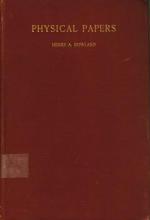|
This section contains 395 words (approx. 2 pages at 300 words per page) |
World of Physics on Henry Augustus Rowland
Henry Augustus Rowland, a founder of modern physics, was recognized primarily for his research into electromagnetism and development of diffraction grating for spectroscopes. Born in Honesdale, Pennsylvania, Rowland was the son of a long line of Yale-trained ministers. Unlike his forefathers, Rowland was more interested in science than the ministry. As a result, he attended the Rensselaer Polytechnic Institute in Troy, New York, where he earned a degree in civil engineering in 1870. Rowland began his career as a railroad surveyor and as a teacher for the College of Wooster. In 1872, he returned to Rensselaer to teach physics and, in 1876, became chair of the physics department at the newly formed Johns Hopkins University in Balitmore.
Before joining Johns Hopkins, Rowland conducted research in the laboratory of German physicist Hermann von Helmholtz (1821-1894) in Berlin. It was there that Rowland demonstrated that an electric charge on a moving body had the exact same magnetic effect as an electric current moving through a conductor. As a result, he was the first to demonstrate conclusively that charged bodies in motion produce magnetic effects. Later, Rowland confirmed that the electromagnetic/electrostatic ratio was equal to the speed of the light. His trailblazing experiments included establishing the value of ohm and the mechanical equivalent of heat. Rowland gained the most fame for inventing a new spectral grating machine that automatically focused light. Rowland's spectrograph reduced to a few hours what had previously taken several days to analyze, revolutionizing optics and opening the way to modern spectroscopy. Rowland's own use of the spectrograph included re-mapping the solar spectrum and developing highly accurate wavelength tables. For his spectrograph, Rowland won a gold medal at the 1890 Paris Exposition.
At the age of 42, Rowland married Henrietta Harrison, and the couple had three children. Although Rowland was an advocate of science for science's sake, not for the purpose of making money (for example, he sold his spectrographs at cost to scientists around the world), he turned his attention to making money after taking a physical for an insurance policy. Diagnosed with diabetes in the days prior to insulin therapy and told that he had only 10-15 years to live, Roland began consulting to the telegraph and hydroelectric power businesses to secure his family's financial future. Rowland died in 1901 and according to his wishes, was cremated and buried in the wall of his basement laboratory.
|
This section contains 395 words (approx. 2 pages at 300 words per page) |


